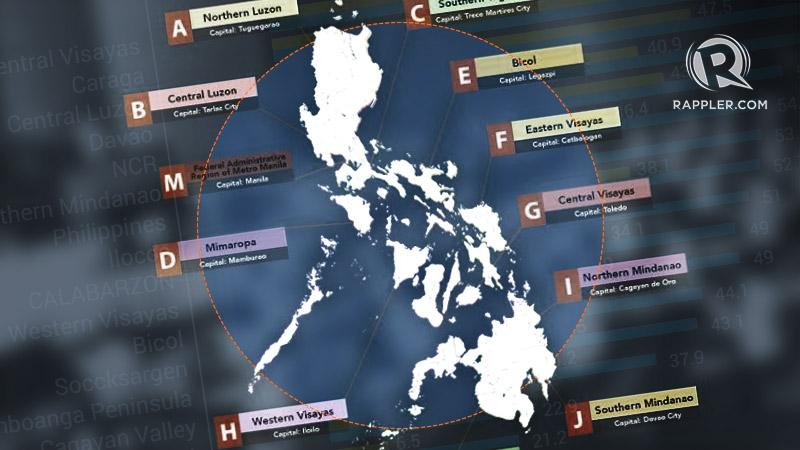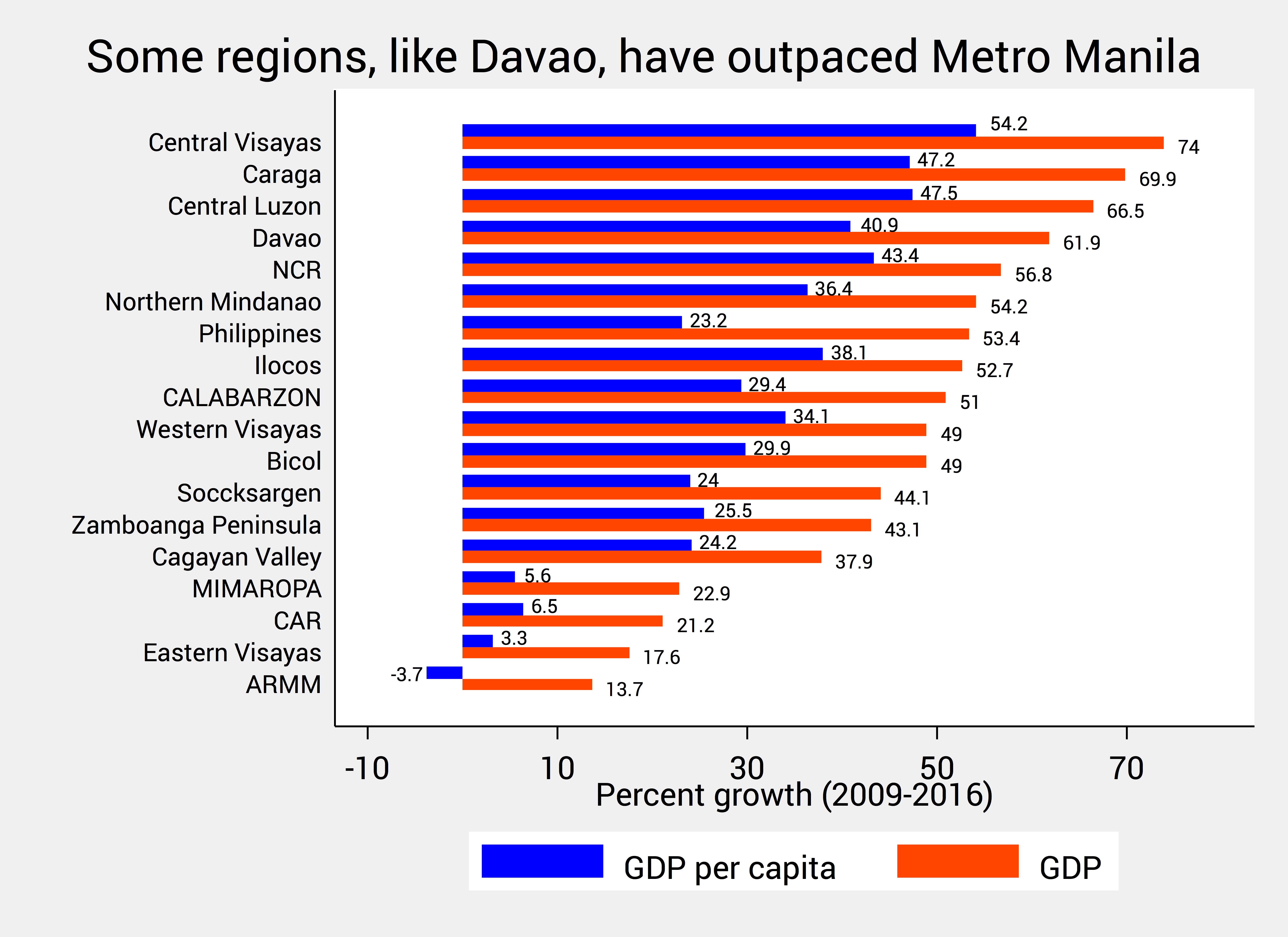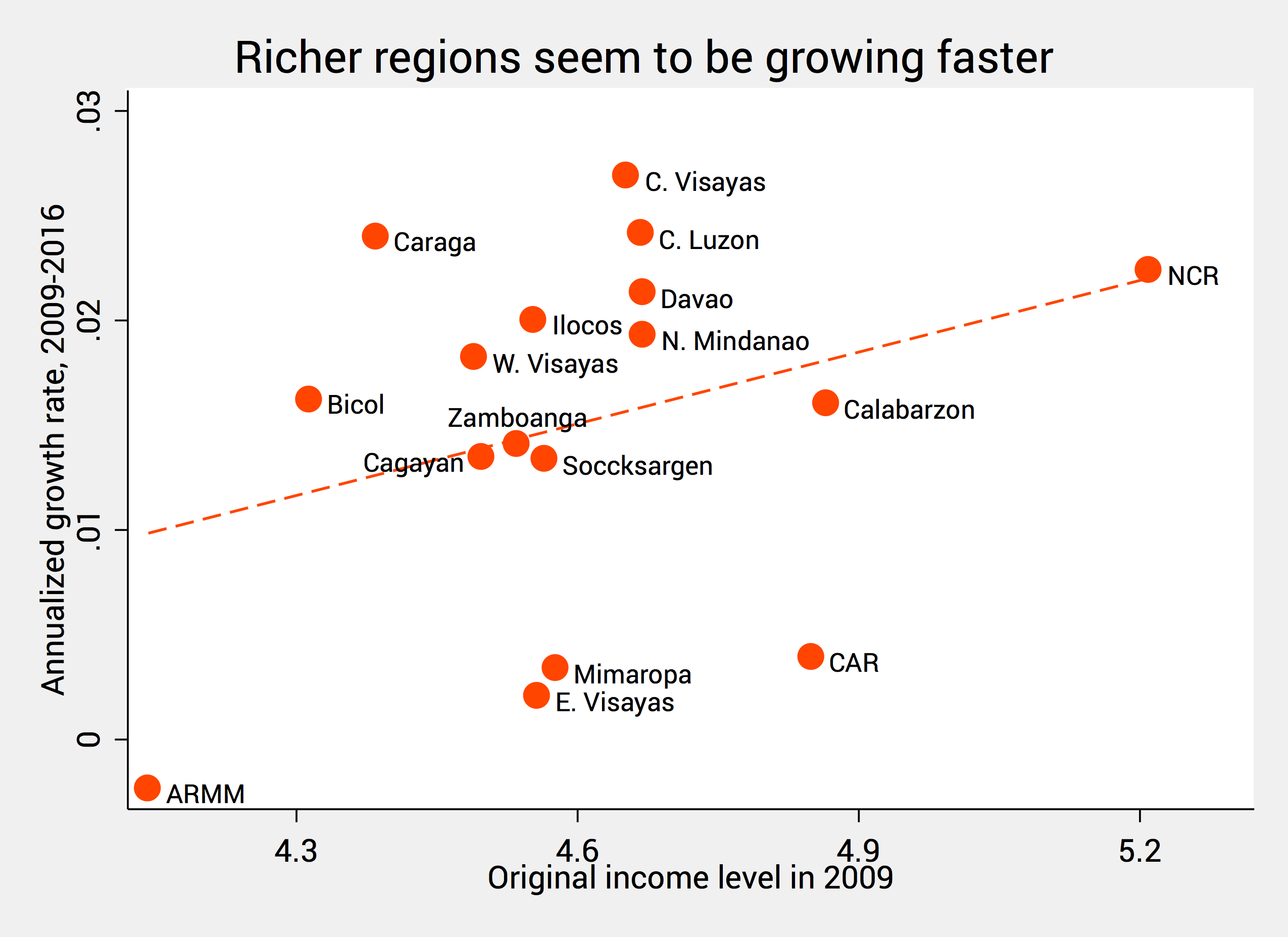

A few days ago, President Duterte’s political party bared the details of their proposed overhaul to the Constitution.
Federalism, they say, will solve key economic problems that have long ailed our country, especially the “imperial” nature of Metro Manila and the long-standing “imbalances” and inequalities between the regions.
In this article I use data to show that many regions are indeed lagging behind Metro Manila. But federalism will not necessarily solve these economic disparities. In fact, federalism might worsen them.
Some regions are outpacing Metro Manila
The executive summary of PDP-Laban’s proposal for federalism begins by denouncing the “imperial” status of Metro Manila.
They say that such an extraordinary concentration of political and economic power has resulted in a “grave imbalance in the distribution of resources among regions and local government units” over time. In turn, this has led to inequality, social unrest, and armed uprisings like those in Mindanao.
Data confirm that Metro Manila is the country’s economic behemoth: in 2016 it accounted for 37% (more than a third) of the country’s total output or GDP (gross domestic product). Together with nearby regions Calabarzon (17%) and Central Luzon (10%), these 3 regions accounted for 64% (or nearly two-thirds) of GDP.
But even if Metro Manila is the largest region, it’s not the fastest-growing. The orange bars in Figure 1 show that this distinction belongs to Central Visayas (which grew by 74% from 2009 to 2016), followed by Caraga (69.9%), Central Luzon (66.5%), and Duterte’s home region of Davao (61.9%).

Figure 1. Source: PSA. Regional GDP in 2000 prices.
NCR or National Capital Region came in at fifth (56.8%), followed by Northern Mindanao (54.2%). This ranking is roughly the same if we look at the blue bars instead, which represent the growth of average incomes (GDP per person).
But more regions are lagging behind
Although some regions are outpacing Metro Manila, many more are lagging behind. This is where the real problem lies.
Figure 2 below shows that rich regions are seemingly growing faster than poor ones. This is shown by the upward pattern of the dots.
This is not the pattern we’re supposed to be seeing: economic growth theory suggests that poorer regions (like ARMM and Bicol) should be growing faster than richer ones (like NCR or Calabarzon). This is otherwise known as “regional convergence.”
But instead, the dots show the opposite pattern. As long as many poor regions continue to grow slowly, they will never catch up with Metro Manila. Rather than converge, the regions will diverge.

Figure 2. Source: Author’s calculations of PSA data from 2009-2016. Values in log terms. Note that the pattern is tenuous. If we remove ARMM, there seems to be no relation between annualized growth rates and 2009 income levels (that is, there’s neither regional convergence nor divergence).
Regional divergence is also shown by the increasing dispersion of average incomes between the regions (statistically, the standard deviation of per-capita incomes has increased by 11% from 2009 to 2016).
Federalism won’t ensure faster catch up
With many poor regions lagging behind, can federalism – as envisioned by Duterte and his party – correct this? Will federalism make poorer regions catch up faster?
Not necessarily.
Economic growth occurs when people are more productive. Productivity, in turn, is proportional to the degree of investments made by the private and public sectors, whether in the form of physical capital (roads, bridges, airports) or human capital (education, health, training).
Federalism won’t foster growth if the Regional Governments fail to promote investments or raise people’s productivity. Here are two reasons why this is more likely to happen than not.
1) Investments will still flock to richer regions
Duterte’s federalism will create 11 or so Regional Governments, each of which will have the power to create its own laws, regulations, and taxes suited to the particular needs of its constituents.
To promote growth, each Regional Government will have to boost investments, either through tax revenues or by attracting private investors.
But poor regions are doubly at a disadvantage. Places like ARMM or Eastern Visayas, for example, have small economies to begin with, and have fewer goods and services to tax. Their small economies will yield little tax revenues they can invest for their future growth.
By contrast, richer regions like NCR and Calabarzon already have large economies and substantial tax revenues at the outset, which they can use to fund major public investments or offer incentives to prospective investors (like tax holidays or subsidies).
Hence, even with federalism in place, investments could still end up flocking to richer regions rather than poorer regions.
To remedy these initial imbalances, the proposed federal setup will include “intergovernmental transfers”: that is, part of taxes from rich regions will be transferred to poor regions in need of fiscal assistance.
But aside from the logistical challenges – Finance Secretary Sonny Dominguez says it could be a “nightmare” – many studies have found that “fiscal equalization” of this sort typically doesn’t encourage poor regions to be more productive. If anything, it tends to make them more dependent on richer regions.
It’s always fun to spend money you didn’t earn. This same principle applies to Regional Governments of various incomes.
2) Greater political autonomy could raise the cost of doing business
Local politics in the Philippines is chiefly characterized by “patronage”: local leaders see themselves as patrons who provide various services for their constituents – like basketball courts with their names on the roofs, or ambulances with their faces plastered on the doors. In return, constituents pay back with their votes.
Patronage politics explains why many mayors and governors give special treatment to businesses owned by themselves, family, and friends. They are also known to impose strict standards, extract bribes, or even deny permits to businesses that threaten special interests.
Duterte’s federalism will grant political autonomy to local officials, but given our political culture this could also afford them more economic power in their respective jurisdictions.
This is worrisome for 3 reasons. First, local leaders and elites might capture larger segments of their respective economies. This will defeat federalism’s ostensible purpose of promoting inclusive growth.
Second, stifled competition could mean that constituents will face higher prices and lower quality for the goods and services they buy.
Third, dealing with 11 different sets of laws, regulatory standards, and tax systems nationwide – one for each Regional Government – could raise the overall cost of doing business across the country. Small and medium enterprises (SMEs) wishing to expand could hurt the most.
All in all, the proposals for federalism should not be blind to the political and economic realities on the ground. Otherwise, federalism will only be fraught with many unintended consequences.
Let’s read between the lines
It’s true that many regions of the Philippines are lagging behind Metro Manila in terms of incomes and living standards.
But there’s simply no data or evidence to suggest that the proposed shift to a federal system will make poorer regions catch up faster.
In fact, if we ignore the political and economic realities on the ground – like patronage politics – federalism could even worsen existing regional inequalities.
Just look at ARMM: nearly 30 years since it gained autonomy and established its own regional government, it has remained the poorest region in the country.
Many of the proposed changes to the Constitution also have nothing to do with regional development at all. These include extending term limits (Duterte and all lawmakers could serve for another 10 years), abolishing the office of the vice president, and indefinitely postponing elections.
Truth to tell, if you carefully read the proposal, Duterte’s federalism looks less like a plan to promote regional development, and more like a ploy to concentrate political power on Duterte and his political party for the next 5 to 10 years.
Before it's too late, let us all read between the lines. – Rappler.com
The author is a PhD candidate and teaching fellow at the UP School of Economics. His views are independent of the views of his affiliations. Follow JC on Twitter: @jcpunongbayan.